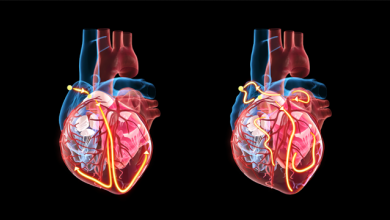Understanding Cardiac Arrhythmias: V Fib vs. V-Tach
The human heart is a remarkable organ, tirelessly pumping blood to keep us alive. At its core, this vital function relies on a synchronized rhythm—a rhythmic beating that’s as dependable as a metronome. But what happens when this rhythm falters? That’s where cardiac arrhythmias come into play.
Explaining the Basics of Cardiac Rhythm
Cardiac rhythm refers to the coordinated, rhythmic contraction and relaxation of the heart’s chambers, primarily the atria and ventricles. This precise choreography ensures that blood is pumped efficiently throughout the body. A deviation from this rhythmic pattern results in a cardiac arrhythmia.

v fib vs v tach
The Importance of Recognizing Arrhythmias
Recognizing and understanding cardiac arrhythmias is crucial because they can significantly impact heart health. Two such arrhythmias, ventricular fibrillation (V-Fib) and ventricular tachycardia (V-Tach), demand immediate attention due to their life-threatening nature. In this article, we delve into the distinctions between V Fib and V Tach, shedding light on their causes, symptoms, diagnosis, and management.
Now, let’s move on to the next section:
What is V-Fib?
Defining Ventricular Fibrillation (V-Fib)
Ventricular fibrillation (V-Fib) is a severe cardiac arrhythmia characterized by rapid, irregular, and chaotic electrical activity within the ventricles—the heart’s lower chambers. In V-Fib, the heart quivers ineffectively instead of pumping blood, leading to an immediate cessation of blood flow to vital organs.
Characteristics and Mechanisms
V Fib is often described as chaotic electrical “noise” on an electrocardiogram (ECG) due to the absence of organized ventricular contractions. This arrhythmia disrupts the heart’s ability to pump oxygenated blood, which can lead to loss of consciousness and death within minutes if not promptly treated.
Symptoms and Warning Signs
One of the concerning aspects of V-Fib is the sudden onset of symptoms, which can include:
Loss of consciousness or fainting
Absence of a palpable pulse
Gasping for breath or agonal breathing
Rapid deterioration of the overall condition
V-Fib is a dire emergency that demands immediate intervention. The next section will explore V-Tach:
What is V-Tach?
Exploring Ventricular Tachycardia (V-Tach)
Ventricular tachycardia (V-Tach) is another potentially life-threatening cardiac arrhythmia characterized by rapid and abnormal heartbeats originating in the ventricles. In V-Tach, the heart beats too quickly to effectively pump blood, compromising its ability to supply oxygen to the body.
Differentiating V-Tach from V-Fib
While both V-Fib and V-Tach involve irregular ventricular rhythms, they differ in critical ways. V-Tach features rapid but coordinated contractions, whereas V Fib exhibits chaotic and uncoordinated electrical activity with no effective contractions. Understanding these differences is essential for appropriate intervention.
Common Causes and Triggers
V-Tach can result from various factors, including heart disease, electrolyte imbalances, medications, and structural heart abnormalities. Identifying and addressing the underlying cause is crucial in managing and preventing future episodes of V-Tach.
Symptoms and Effects
Highlighting Symptoms of V-Fib
Ventricular fibrillation (V-Fib) is a medical emergency that often manifests suddenly and severely. Recognizing the symptoms can be a matter of life and death:
Loss of Consciousness:
One of the most alarming signs is an almost immediate loss of consciousness.
No Palpable Pulse:
V Fib leads to a lack of effective heartbeat, resulting in no palpable pulse.
Gasping for Breath:
As oxygen levels plummet, gasping or agonal breathing may occur.
Rapid Deterioration:
Without intervention, V-Fib can rapidly lead to brain damage or death within minutes.
Symptoms and Impact of V-Tach
Ventricular tachycardia (V-Tach) also presents distinct symptoms, though it differs from V-Fib in terms of rhythm and prognosis:
Rapid Heart Rate:
V-Tach is characterized by a heart rate of over 100 beats per minute.
Dizziness or Lightheadedness:
Some individuals may experience dizziness, palpitations, or lightheadedness during V-Tach episodes.
Chest Discomfort:
Chest discomfort or pain may occur, resembling angina.
Shortness of Breath:
A rapid heartbeat can lead to shortness of breath, especially during physical activity.
Recognizing Life-Threatening Situations
Both V-Fib and V-Tach are critical situations that necessitate immediate medical attention. If you witness someone experiencing these symptoms or if you suspect you’re having an episode, call 911 or seek emergency care promptly.
Diagnosis and Testing
Medical Tests for Arrhythmia Detection
Diagnosing and distinguishing between V-Fib and V-Tach requires specialized medical tests, such as:
Electrocardiogram (ECG or EKG):
A common initial test to monitor electrical activity in the heart.
Holter Monitoring:
Continuous ECG recording over 24 hours can capture intermittent arrhythmias.
Event Monitoring:
Similar to Holter monitoring but over a more extended period to detect less frequent arrhythmias.
The Role of Holter Monitoring
Holter monitoring is particularly valuable in capturing intermittent arrhythmias like V-Tach, which may not appear during a brief visit to the doctor’s office. This continuous monitoring can aid in accurate diagnosis
Treatment Options
Immediate Response to V-Fib and V-Tach
Swift action is critical when dealing with V-Fib or V-Tach, as both can quickly escalate to life-threatening situations:
Cardiopulmonary Resuscitation (CPR):
Bystander CPR can be a lifesaver, providing chest compressions and rescue breaths until medical help arrives.
Automated External Defibrillator (AED):
An AED is a crucial tool that can deliver an electric shock to restore normal heart rhythm. They are user-friendly and found in many public places.
Medications and Anti-Arrhythmic Drugs
For those at risk or with recurring arrhythmias, medications and anti-arrhythmic drugs may be prescribed:
Beta-Blockers:
These can help regulate heart rate and reduce the risk of arrhythmias.
Amiodarone:
An anti-arrhythmic medication that can be effective in managing V Tach or preventing its recurrence.
Implantable Cardioverter-Defibrillator (ICD):
In some cases, an ICD may be implanted to monitor and correct arrhythmias.
When to Seek Medical Help
Knowing When to Call 911
The urgency of seeking medical help cannot be overstated when dealing with V-Fib or V-Tach:
If you or someone else experiences loss of consciousness, no pulse, or gasping for breath, call 911 immediately.
Do not wait for symptoms to improve, as rapid intervention is essential.
Importance of Prompt Action
Time is of the essence. Immediate response and skilled medical attention significantly increase the chances of survival and minimize potential damage to the heart and brain.
Long-Term Management
Lifestyle Changes and Risk Reduction
For individuals diagnosed with V-Fib or V-Tach, long-term management involves several key aspects:
Medication Adherence:
If prescribed anti-arrhythmic drugs, it’s crucial to take them as directed by your healthcare provider.
Regular Follow-ups:
Scheduled check-ups allow your healthcare team to monitor your heart’s health and adjust treatment if necessary.
Healthy Lifestyle:
Adopting heart-healthy habits, including a balanced diet, regular exercise, and stress management, can reduce the risk of future arrhythmias.
Implantable Devices and Cardiac Rehabilitation
In some cases, individuals may benefit from implantable devices such as an Implantable Cardioverter-Defibrillator (ICD) or cardiac resynchronization therapy. Cardiac rehabilitation programs may also be recommended to improve heart health and overall well-being.
Prevention and Risk Factors
Identifying Risk Factors for Arrhythmias
Understanding the factors that contribute to V-Fib and V-Tach is essential for prevention:
Heart Disease:
Underlying heart conditions, such as coronary artery disease, increase the risk.
Electrolyte Imbalances:
Abnormal levels of potassium, calcium, or magnesium can trigger arrhythmias.
Medications:
Some medications may disrupt normal heart rhythm, so it’s crucial to discuss potential side effects with your healthcare provider.
Structural Heart Abnormalities:
Congenital heart defects or prior heart surgeries can make arrhythmias more likely.
Strategies for Prevention
Reducing the risk of V-Fib and V-Tach involves both medical and lifestyle approaches:
Medication Management:
If you’re prescribed medications, take them as directed and attend regular follow-ups.
Dietary Choices:
Consume a heart-healthy diet rich in fruits, vegetables, whole grains, and lean proteins.
Physical Activity:
Engage in regular, moderate-intensity exercise as recommended by your healthcare provider.
Stress Reduction:
Manage stress through techniques like mindfulness, meditation, or relaxation exercises.
Living with Heart Health in Mind
Embracing a heart-healthy lifestyle and addressing risk factors can go a long way in preventing future arrhythmias. Regular communication with your healthcare provider is vital to monitor your heart’s health.
frequently asked questions
Q: What is the difference between V-Fib and V-Tach?
A: V-Fib (ventricular fibrillation) and V-Tach (ventricular tachycardia) are both cardiac arrhythmias, but they differ in terms of rhythm and severity. V-Fib is characterized by chaotic and uncoordinated electrical activity in the ventricles, while V-Tach involves rapid but coordinated ventricular contractions.
Q: Are V-Fib and V-Tach life-threatening?
A: Yes, both V-Fib and V-Tach can be life-threatening. V-Fib, in particular, is a dire emergency that can lead to loss of consciousness and death within minutes if not treated promptly.
Q: What are the symptoms of V-Fib?
A: Symptoms of V-Fib include loss of consciousness, absence of a palpable pulse, gasping for breath, and rapid deterioration of the overall condition.
Q: Can V-Tach lead to V Fib?
A: Yes, V-Tach can potentially degenerate into V-Fib, making early recognition and intervention crucial to prevent this progression.
Q: How are V-Fib and V-Tach diagnosed?
A: Diagnosis involves medical tests such as an electrocardiogram (ECG), Holter monitoring, and event monitoring, which help identify the specific arrhythmia and guide treatment.
Q: What is the immediate response to V-Fib and V-Tach?
A: The immediate response includes calling 911, performing cardiopulmonary resuscitation (CPR), and using an automated external defibrillator (AED) if available.
Q: Can lifestyle changes reduce the risk of V-Fib and V-Tach?
A: Yes, adopting a heart-healthy lifestyle, including a balanced diet, regular exercise, and stress management, can reduce the risk of arrhythmias.
Q: Are there medications for long-term management of V-Fib and V-Tach?
A: Yes, anti-arrhythmic medications like amiodarone and beta-blockers may be prescribed for long-term management.
Q: What is an Implantable Cardioverter-Defibrillator (ICD)?
A: An ICD is a device implanted in the chest to monitor heart rhythm and deliver electric shocks if a life-threatening arrhythmia like V-Fib or V-Tach is detected.
Q: Can structural heart abnormalities lead to V-Fib or V-Tach?
A: Yes, structural heart abnormalities, whether congenital or acquired, can increase the risk of developing these arrhythmias.
Conclusion
In summary, ventricular fibrillation (V-Fib) and ventricular tachycardia (V-Tach) are serious cardiac arrhythmias that demand immediate attention. Understanding the differences between them, their symptoms, diagnosis, and treatment options is crucial for both patients and healthcare providers.




